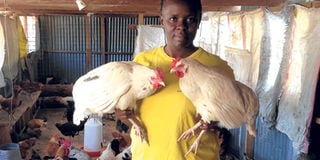How I cross my chickens for more income

Marion Dome in her poultry farm in Eldoret. STANLEY KIMUGE | NATION MEDIA GROUP
What you need to know:
- “Some farmers use a cock to serve hens for about two years. This is wrong because the offspring become weaker and prone to diseases.” A crossbreed chick, according to the farmer, lays eggs every day and matures faster.
- Inside her homestead, the farmer has constructed three wooden pens. One is for layers, the other for chicks while the last one hosts over three-week-old chickens.
- Dr Mary Ambula, an animal scientist at Egerton University, acknowledges that selective breeding leads to better chickens. She says that indigenous hens normally lay 40 to 50g eggs. However, those that are crossbred lay eggs weighing 50 to 57g.
Marion Dome smiles as she watches her chicks chirp and run inside the brooder located in a pen in her quarter-acre farm in Maili Nne, 7km west of Eldoret town.
Looking at the chicks, they are bigger and healthier than the normal ones.
“The chicks are bigger because they are from crossbreed chickens,” she says.
“I get different chicken breeds and cross with others. I have crossbred, for instance, the indigenous cocks with Sasso, Kari kienyeji and Bovan Black hens,” adds Marion, who keeps over 500 chickens, 200 of them which are layers.
Inside her homestead, the farmer has constructed three wooden pens. One is for layers, the other for chicks while the last one hosts over three-week-old chickens.
“I separate them for three reasons. First is to avoid cannibalism, second is to keep diseases at bay and lastly to curb inbreeding,” explains Marion, who sources for new cockerels after every six months.
She gets the cocks from fellow farmers and uses them to serve the hens. Each cock serves eight hens.
“I started doing this out of curiosity. I crossbred an indigenous cock with a Sasso hen and realised the chicks were bigger.”
The farmers who bought the chicks noticed their bigger sizes and kept on coming for more.
“I sell about 400 chicks every month which I hatch using an incubator. I collect over 100 eggs every day,” says the mother of two girls. A day-old chick goes for Sh100 and a week-old at Sh150.
With crossbreeding, according to the farmer, she ends up with birds that produce more as layers and broilers are heavier.
COCK
“Some farmers use a cock to serve hens for about two years. This is wrong because the offspring become weaker and prone to diseases.” A crossbreed chick, according to the farmer, lays eggs every day and matures faster.
Besides selective breeding, Marion follows a strict feeding regime. The farmer makes her own feeds using a mill shredder and a 500kg capacity mixer.
“I grind maize and mix with cotton and sunflower seeds and dagaa (omena) to make nutritious feeds. I travel to Mbita regularly to collect dagaa.”
The layers consume a 40kg bag of feeds every day. She advises farmers who want to keep chickens to give great attention to feeds. “People tend to give layers a lot of calcium, which hardens shells making the birds fail to hatch eggs on time.”
Dr Mary Ambula, an animal scientist at Egerton University, acknowledges that selective breeding leads to better chickens. She says that indigenous hens normally lay 40 to 50g eggs. However, those that are crossbred lay eggs weighing 50 to 57g.
“An indigenous breed produces about 200 eggs annually but when one crosses it, the crossbreed offers more than 250 eggs.” The offspring of those bred also tend to mature faster and will start laying eggs at about six months.
“Most indigenous chicks start to produce eggs at seven to eight months, the crossbreed offspring from 20 weeks they will drop eggs.”
However, there are challenges that come with crossbreeding, according to the expert.
“While the crossbreed is better, it normally tends to be less resistant to diseases like Newcastle, gumboro and sometimes coccidiosis.”
“They will sit on eggs for only five days then walk away from brooding nests, instead of the whole 21 days,” she adds.





